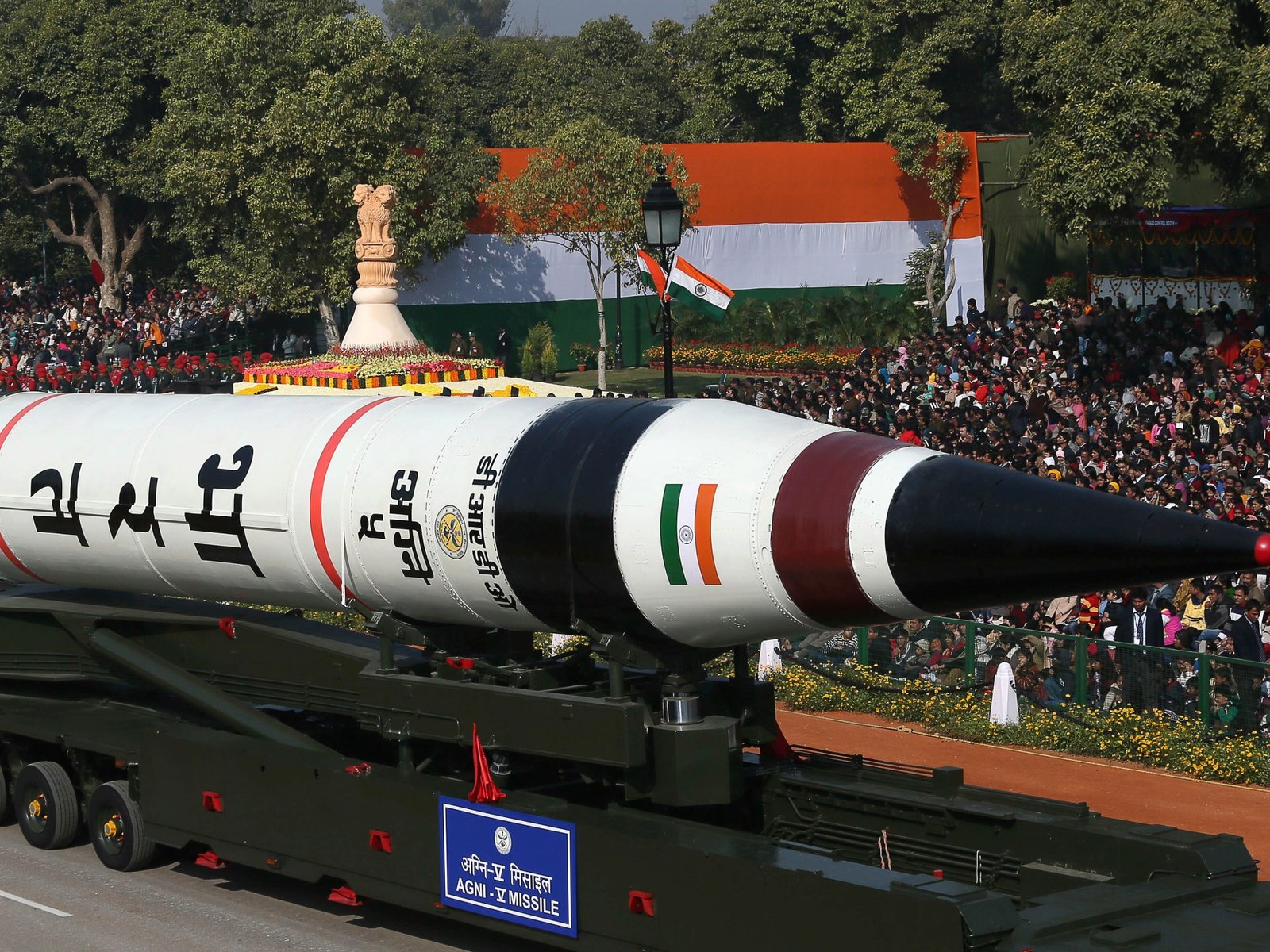Travel Guides & Articles
India-Pakistan missile race heats up, but China in crosshairs, too | India-Pakistan Tensions News

Islamabad, Pakistan – India on August 20 announced that it had successfully test-fired Agni-V, its intermediate-range ballistic missile, from a test range in Odisha on its eastern Bay of Bengal coast.
The Agni-V, meaning “fire” in Sanskrit, is 17.5 metres long, weighs 50,000kg, and can carry more than 1,000kg of nuclear or conventional payload. Capable of travelling more than 5,000km at hypersonic speeds of nearly 30,000km per hour, it is among the fastest ballistic missiles in the world.
The Agni test came exactly a week after Pakistan announced the formation of a new Army Rocket Force Command (ARFC), aimed, say experts, at plugging holes in its defensive posture exposed by India during the four-day conflict between the nuclear-armed neighbours in May.
But experts say the latest Indian test might be a message less for Pakistan and more for another neighbour that New Delhi is cautiously warming up to again: China.
The Agni’s range puts most of Asia, including China’s northern regions, and parts of Europe within reach. This was the missile’s 10th test since 2012 and its first since March last year, but its timing, say analysts, was significant.
It came just ahead of Indian Prime Minister Narendra Modi’s trip to China for the Shanghai Cooperation Organisation (SCO) summit, amid a thaw in ties – after years of tension over their disputed border – that has been accelerated by United States President Donald Trump’s tariff war against India. On Wednesday, the US tariffs on Indian goods doubled to 50 percent amid tensions over New Delhi’s oil purchases from Russia.
Yet despite that shift in ties with Beijing, India continues to view China as its primary threat in the neighbourhood, say experts, underscoring the complex relationship between the world’s two most populous nations. And it’s at China that India’s development of medium and long-range missiles is primarily aimed, they say.
India’s missile advantage over Pakistan
While India acknowledged losing an unspecified number of fighter jets during the May skirmish with Pakistan, it also inflicted significant damage on Pakistani military bases, particularly with its supersonic BrahMos cruise missiles.
The BrahMos, capable of carrying nuclear or conventional payloads of up to 300kg, has a range of about 500km. Its low altitude, terrain-hugging trajectory and blistering speed make it difficult to intercept, allowing it to penetrate Pakistani territory with relative ease.
Many experts argue that this context shows the Agni-V test is not directly linked to Pakistan’s announcement of the ARFC. Instead, they say, the test was likely a signal to China. Indian and Chinese troops were in an eyeball-to-eyeball standoff along their disputed Himalayan border for four years after a deadly clash in 2020, before Modi met Chinese President Xi Jinping in Russia in October 2024 to begin a process of detente.
Modi’s visit to China for the SCO summit on Sunday will be his first to that country since 2018. In the past, India has often felt betrayed by overtures to China, which, it claims, have frequently been followed by aggression from Beijing along their border.
“India’s requirement for a long-range, but not intercontinental, missile is dictated by its threat perception of China,” Manpreet Sethi, a distinguished fellow at the New Delhi-based Centre for Air Power Studies, told Al Jazeera.
“Agni-V is a nuclear-capable ballistic missile of 5,000km range, which India has been developing as part of its nuclear deterrence capability against China. It has no relevance to Pakistan,” Sethi added.
Christopher Clary, assistant professor of political science at the University at Albany, agreed.
“While the Agni-V might be usable against Pakistan, its primary mission would involve strikes on China,” he told Al Jazeera. “China’s east coast, where its most economically and politically important cities are situated, is hard to reach from India and requires long-range missiles.”
Missile race across South Asia
India and Pakistan have been steadily expanding their missile arsenals in recent years, unveiling new systems with increasing reach.
Before announcing the ARFC, Pakistan showcased the Fatah-4, a cruise missile with a 750km range and the capability to carry both conventional and nuclear warheads.
India, meanwhile, is working on Agni-VI, which is expected to have a range exceeding 10,000km and carry multiple independently targetable reentry vehicles (MIRVs), a capability already present in Agni-V.
MIRV-enabled missiles can carry several nuclear warheads, each capable of striking a separate target, significantly boosting their destructive potential.
Mansoor Ahmed, an honorary lecturer at the Strategic and Defence Studies Centre, Australian National University, said India’s latest test demonstrates its growing intercontinental missile capabilities.
“With India working on different variants of Agni with multiple capabilities, this test was a technological demonstrator for India’s emerging submarine-launched ballistic missile (SLBM) capability,” Ahmed said.
“Depending on the configuration of the warheads for India’s SLBMs, India will be able to deploy anywhere between 200-300 warheads on its SSBN force alone over the next decade,” he added. SSBNs (ship, submersible, ballistic, nuclear) are nuclear-powered submarines designed to carry SLBMs armed with nuclear warheads. India currently has two SSBNs in service, with two more under construction.
Pakistan, by contrast, does not possess long-range missiles or nuclear submarines. Its longest-range operational ballistic missile, the Shaheen-III, has a range of 2,750km.
“Pakistan also has South Asia’s first MIRV-enabled ballistic missile called Ababeel, which can strike up to 2,200km range, but it is the shortest-ranged MIRV-enabled system deployed by any nuclear-armed state,” Ahmed said.
Tughral Yamin, a former Pakistani army brigadier and nuclear policy scholar, said the countries’ missile ambitions reflect divergent priorities.
“Pakistan’s programme is entirely Indian-specific and defensive in nature, while India’s ambitions extend beyond the subcontinent. Its long-range systems are designed for global power projection, particularly vis-a-vis China, and to establish itself as a great power with credible deterrence against major states,” said Yamin, author of The Evolution of Nuclear Deterrence in South Asia.
But some experts say Pakistan’s missile development programme isn’t only about India.
Ashley J Tellis, the Tata Chair for Strategic Affairs at the Carnegie Endowment for International Peace (CEIP), said that while “India wants to be able to range China and Pakistan,” Islamabad is building the capability to keep Israel – and even the US – in its range, in addition to India.
“The conventional missile force in both countries is designed to strike critical targets without putting manned strike aircraft at risk,” Tellis told Al Jazeera.
US concerns over Pakistan’s ambitions, quiet acceptance of India’s rise
Pakistan’s missile programme came under intense spotlight in December last year when a senior White House official warned of Islamabad’s growing ambitions.
Jon Finer, serving in the then-Biden administration, described Pakistan’s pursuit of advanced missile technology as an “emerging threat” to the United States.
“If the trend continues, Pakistan will have the capability to strike targets well beyond South Asia, including in the United States,” Finer said during an event at the CEIP.
By contrast, Tellis said India’s growing arsenal is not viewed as destabilising by Washington or its allies.
“Pakistan’s capabilities in contrast are viewed as unsettling because the early history of its nuclear programme had anti-Western overtones, sentiments that have taken on a specific anti-US colouration after 9/11 and the Abbottabad raid,” Tellis explained, referring to the US capture of Osama bin Laden inside Pakistan in 2011.
Ahmed, the Canberra-based academic, said India’s long-range missile development is openly supported by Western powers as part of the US-led Asia Pacific strategy.
“The US and European powers have viewed and encouraged India to act as a net security provider. The India-US civil nuclear deal and the Nuclear Suppliers Group (NSG) waiver effectively gave India de facto nuclear weapons status without signing the Non-Proliferation Treaty (NPT),” he said.
The NPT is a Cold War-era treaty aimed at preventing the spread of nuclear weapons, promoting the peaceful use of nuclear energy and advancing the goal of nuclear disarmament. It formally recognises only the United States, Russia, China, France and Britain as nuclear weapons states.
But the 2008 waiver from the NSG – a club of 48 nations that sell nuclear material and technology – allowed India to engage in global nuclear trade despite not being an NPT signatory, a unique status that elevated its global standing.
Clary from the University of Albany, however, pointed out that unlike the Biden administration, the current Trump White House has not expressed any concerns about Pakistan’s missile programme – or about India’s Agni-V test.
“For now, so long as Pakistan keeps its missile tests limited to ranges already demonstrated by the Shaheen-III and Ababeel, I don’t expect Western governments to concern themselves overly with South Asia’s missile developments,” he said. “There are more than enough other problems to keep them busy.”
Travel Guides & Articles
Fatehpur Sikri, India, travel guide: Seven highlights to see

Seven wonders within Fatehpur Sikri, India
This monumental Mughal capital 37 kilometres outside Agra was founded in 1571 but lasted scant decades. The magnificently mournful ruins are one of India’s most underrated sights.
1 Make a grand entrance through Victory Gateway
As you lurch out of Agra, dodging cars and camel carts, your first sight of this ruined city is an immense hilltop gateway, one of the world’s biggest, wobbling like a mirage in the heat. Victory Gateway was built in 1602 from red sandstone and white marble to commemorate Emperor Akbar’s military triumphs, although its Persian inscription warns the world doesn’t last. This by itself qualifies as a mighty monument, and the views are splendid.
2 Pause in admiration inside the mosque
Step through the gateway into the courtyard of the Friday Mosque and you get the first impact of this tremendous ensemble. Everything is built of red sandstone, everything outsized, and yet the decorative detail – window frames, balconies, roof brackets – wonderfully carved. The mosque is one of India’s finest and largest and centres on the tomb of a Sufi, inlaid with mother-of-pearl. Local women come to tie strings on the marble lattice in hope of being granted children.
3 Check out the architecture in the Audience Hall
This gloriously startling building in the royal quarter is where Akbar consulted advisers. The Diwan-i-Khas has wall recesses that served as bookshelves for royal documents and texts. However, your eyes will surely be on the enormous and wildly ornate octagonal pillar of the main hall, which rises from the centre of the room like the handle of an umbrella and props up an elevated walkway that resembles the balcony in an opera house.
4 Look up in the Imperial Treasury
Fatehpur Sikri shows wide Hindu, Islamic and Persian influences but this genius building next to the Audience Hall takes inspiration from Jain temple architecture and decorative sculpture. Stone safes are concealed in the walls, but gaze up: the brackets that hold up the ceiling are embellished with mythical elephant-headed sea monsters, said to guard treasures in the depths of the ocean. In the fields behind, don’t miss the odd-looking spiky tower erected in memory of Akbar’s beloved elephant Hiran.
5 Enjoy the faded frescoes in Mariam’s House
The harem complex has several fine pavilions, some showing Turkish influences and others covered with depictions of swans and horses. The carvings and fretwork are so fine in places you could mistake sandstone for wood. If you’re pressed for time, head straight to Mariam’s House, perhaps the best example. As a bonus, it has bright and sometimes surreal gold-tinted frescoes – look out for the diaphanous woman riding a gigantic parrot.
6 Wander through the other imperial quarters
This is the most impressive part of Fatehpur Sikri, erupting in columns, latticed screens and elaborately decorated architectural elements, and graced with ornamental pools and clipped gardens. Persian verses loop across the emperor’s bedroom or House of Dreams, although judging from his innumerable concubines Akbar spent scant time on sleep. The pool below the elevated kiosk cooled the bedchamber. This is just one of numerous buildings that might take an hour or two to admire.
7 Close your guidebook and get lost
Fatehpur Sikri was planned in the smallest detail: servants’ quarters, lavatory blocks, fountain drainage, masonry rings to hold silk canopies for courtyard shading. Take time to inspect the detail and soak up the melancholy magnificence away from the main visitor axis. Birds wheel overhead and squirrels sun themselves on walls. In the late afternoon the sandstone turns crimson, then orange and subtle pink before the light fades on this abandoned city of lost dreams.
The writer travelled as a guest of Incredible India incredibleindia.gov.in and Malaysia Airlines malaysiaairlines.com
Sign up for the Traveller Deals newsletter
Get exclusive travel deals delivered straight to your inbox. Sign up now.
Traveller Guides
From our partners
Travel Guides & Articles
Heavy rain alert in Delhi–Gurugram: IMD issues an orange alert; travel and safety advisory |

In a recent update, Delhi and its surrounding NCR cities, including Gurugram, Noida, and Faridabad, have received intense rainfall. The India Meteorological Department (IMD) has issued an orange alert for Delhi while a warning of very heavy rainfall and thunderstorms has been issued for Gurugram.Keeping the current situation in view, the District Disaster Management Authority has issued a travel advisory for Gurugram for 2nd September 2025. It reads:On September 1, 2025, Gurugram recorded over 100 mm of rainfall between 3 PM and 7 PM. The India Meteorological Department (IMD) has issued an Orange Alert, forecasting heavy to very heavy rainfall on September 2, 2025.In light of this warning:Corporate offices and private institutions in Gurugram district are advised to ask employees to work from home.
All schools in the district are directed to conduct online classes on September 2, 2025.On the other hand, Delhi too is experiencing non-stop rains which have caused waterlogging and long traffic across roads. Authorities are closely monitoring the Yamuna River too, which is expected to rise close to the danger mark of 206 metres on Tuesday. Low-lying areas are particularly vulnerable to flooding.India Meteorological Department forecastIn the present scenario, the India Meteorological Department (IMD) has issued an orange alert for Delhi for heavy rainfall. Similar alerts have been issued for NCR regions including Noida, Faridabad, and Gurugram. A yellow warning has been issued for Ghaziabad.Not only this, IMD has cautioned that northern India may experience heavy rainfall at least until September 5 especially for Uttarakhand, Himachal Pradesh, and Punjab which are under red and orange alerts.Travel disrupted, airlines issue advisoryAirlines such as IndiGo, Air India, SpiceJet, and Akasa too have issued warnings and advised people of possible delays and cancellations due to poor visibility. Passengers are advised to check flight status before leaving the house.Advisory
It is advised to avoid flood-prone zones, underpasses, and Yamuna ghats.Use public transport.For those in Gurugram, work from home is strongly recommended on September 2 as safety of people is more important.Keep a check on official IMD and local weather updates before planning anything.
Travel Guides & Articles
National parks in Northeast India for rarest wildlife experiences

Northeast India, with its lush forests, rugged mountains, and pristine rivers, is a biodiversity hotspot offering unparalleled opportunities to encounter some of the world’s rarest wildlife. The region’s national parks and sanctuaries protect unique ecosystems and endangered species like the one-horned rhinoceros, red panda, clouded leopard and more. From Manas National Park and Tiger Reserve in Assam to Keibul Lamjao National Park in Manipur, find out what makes these national parks so unique, and what rare creatures these parks have in store for visitors.
-

 Business3 days ago
Business3 days agoThe Guardian view on Trump and the Fed: independence is no substitute for accountability | Editorial
-
Tools & Platforms3 weeks ago
Building Trust in Military AI Starts with Opening the Black Box – War on the Rocks
-

 Ethics & Policy1 month ago
Ethics & Policy1 month agoSDAIA Supports Saudi Arabia’s Leadership in Shaping Global AI Ethics, Policy, and Research – وكالة الأنباء السعودية
-

 Events & Conferences3 months ago
Events & Conferences3 months agoJourney to 1000 models: Scaling Instagram’s recommendation system
-

 Jobs & Careers2 months ago
Jobs & Careers2 months agoMumbai-based Perplexity Alternative Has 60k+ Users Without Funding
-

 Funding & Business2 months ago
Funding & Business2 months agoKayak and Expedia race to build AI travel agents that turn social posts into itineraries
-

 Education2 months ago
Education2 months agoVEX Robotics launches AI-powered classroom robotics system
-

 Podcasts & Talks2 months ago
Podcasts & Talks2 months agoHappy 4th of July! 🎆 Made with Veo 3 in Gemini
-

 Mergers & Acquisitions2 months ago
Mergers & Acquisitions2 months agoDonald Trump suggests US government review subsidies to Elon Musk’s companies
-

 Podcasts & Talks2 months ago
Podcasts & Talks2 months agoOpenAI 🤝 @teamganassi





















